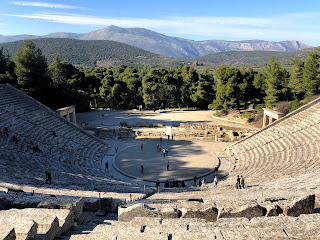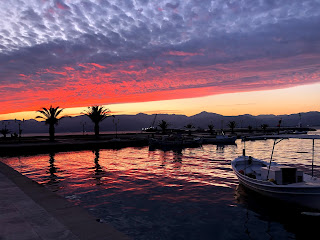Peloponnese Field Trip (Day 4): Greek Hospitality in the Land of Athletes
Today we explored the area of Olympia. Our first stop of the day was at the Archaeological Site of Olympia. It was the site that I was most excited to visit: the birthplace of the Olympic games! In my photography class, we had explored the site through archaeological photographs but none of them conveyed how vast and stately it actually was. I had previously thought that the site was mainly dedicated to the Olympic games and the training of athletes. Little did I know, that it actually only took up a small portion of the site, the main function of it was as a sanctuary dedicated to Zeus. My favorite parts of the site were: 1) the workshop of Phidias, the sculptor of the Statue of Zeus 2) the stadium at Olympia 3) the statue bases leading up the stadium shaming cheaters and 4) the bronze helmet of Miltiades, a general in the Battle of Marathon!
 |
| Temple of Zeus at Olympia |
 |
| Stadium at Olympia |
 |
| Panagiotis and his Family |
The best part of the day, however, was getting to visit our bus driver, Panagiotis’, village. It turns out that Panagiotis is from a small village 15 minutes away from Olympia and his family still lives there! As soon as we arrived, people came out of their homes to say hi and welcome us to their village. When we got to his house, his family had laid out a table with flowers they had picked, oranges from the village, and sweets. We met his wife, two daughters, and his mother and their neighbors.
We started talking to his two daughters, Morena and Grigoria, who told us about their lives, school, the village, and even dating culture. We added each other on Instagram and they told us that they want to be an archaeologist and a doctor. They then gave a tour of their village and told us about the history of their town. Although the current name of the town is named after a shep
 |
| The girls with Morena and Grigoria |
What was also amazing was that in the process of expanding his house, Panagiotis found a statue, some coins, and a shaft grave on his property! He reported the finds to the government so that it could be properly excavated. I often forget that the entirety of Greece is a living archaeological site and that the region has just been continuously built upon.
 |
Listening to the History of the Town |
 |
| Our group with the Papadopoulos Family! |















